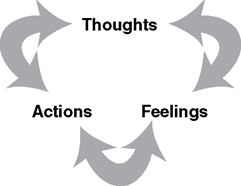Your entire mental life (the biosystem known as the human mind) is defined by and can be broken down into a combination of three basic elements:
1. Thoughts
2. Emotions
3. Behaviors
These three components are not discrete. That is, they do not have clear boundaries and, in fact, are inextricably related to one another. For example, your thoughts clearly affect the way you feel, and your feelings (urges) often drive your behaviors. Nevertheless, these three realms are sufficiently different to provide a commonsense distinction and framework for what constitutes human mental life. And we all know what they mean: we all talk in terms of thinking, feeling, and doing.
It is also important to observe how each of these three elements can (either for good or bad) drive or feed into one another in any direction, as depicted in Figure 1.1
As a very simple example, a negative thought (“How could I have made such a stupid mistake?”) will tend to cause one to feel worse (low self-esteem, incompetence, worthlessness, demoralization, sadness, and so on), and such feelings can evolve into negative actions (“drinking my blues away”). But again, notice that the arrows point in both directions. By drinking your blues away, you may feel guilty, and so on.

Figure 1.1 The inextricable interactions of thoughts, actions, and feelings.
One final point on the core constituents of the human mind: The term “subconscious” (“or subconscious mind”) is often used in many different contexts, and it has no single or precise definition. Also, there is no reliable way to tap into the subconscious mind to find out what it is thinking or feeling. Anyone can claim to understand and interpret the subconscious, but there is no way to scientifically study or prove such claims at this time. All of this greatly limits the significance of the subconscious mind as a definition-bearing concept. As a consequence the term tends to be avoided in academic and scientific settings.
We should not go so far as to say that the subconscious has no meaning at all or that it doesn’t exist. But for all intents and purposes, it does not come into play when trying to understand how the human mind interacts with market trading. So we will leave this concept alone for the rest of this book and instead focus on feelings, thoughts, and actions.
Mental Edge Tips
- Always strive to be aware of and in tune with your thoughts, emotions, and actions and how they are interrelating and driving one another at any given moment in time.
- Trying to understand your subconscious mind is like trying to chase the wind. Merely trying to master your conscious mind (thoughts, emotions, and behaviors) is a plenty difficult task in itself, and I suggest you start there!